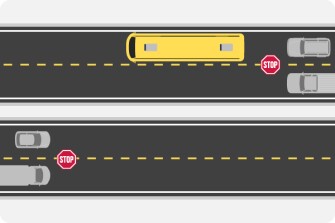When are drivers supposed to stop for school buses?
The question seems simple on the surface, but the answer differs depending on the situation and what state you’re in. Sometimes, only the traffic following the bus is required to stop when the bus’s stop arm is extended and flashing red lights are on. But other times, all cars driving on the same road must stop, regardless of which way they’re going.
To make the situation more difficult, the information often isn’t advertised outside of driver’s license manuals or dedicated weeklong awareness campaigns when school starts in the fall.
That means drivers can go years—sometimes decades—without a refresher on the rules. And, if they move to a new state or travel somewhere new, they might never formally learn the law at all.
That’s problematic because violating the law can carry penalties ranging from a fine to imprisonment, depending on the state. But, more importantly, illegally passing a stopped school bus can have deadly consequences.
Research has found that students are significantly safer traveling to and from school on a school bus than in a car. But the times when children are getting on or off the bus are the most dangerous part of their day, some experts say. That’s when drivers illegally pass stopped buses—which happens an estimated 42 million times per year, according to survey-based estimates from the National Association of State Directors of Pupil Transportation Services. Those violations rarely lead to a child’s death, but every year a handful of children are killed boarding and disembarking from their bus. Even more are injured.
Drivers often claim that they’re unaware of rules that prohibit them from passing stopped buses. So national school transportation organization leaders have been calling for a national public safety campaign—on the scale of the “Click It or Ticket” push around wearing seat belts—to get the word out about the rules of the road around stopped school buses, and the potentially deadly consequences of violating them.
Legislation recently introduced in the U.S. House of Representatives would mandate formal data collection addressing how often people pass stopped buses, which would then be used to craft a public awareness campaign.
Education Week collected the traffic laws in all 50 states and the District of Columbia, addressing when motorists have to—and don’t have to—stop for school buses picking up and dropping off students.
Below is a breakdown of some of the most common scenarios drivers encounter with school buses, and the relevant rules in each state.
Two-lane roads
There is just one traffic scenario for which the same rule applies in all 50 states and the District of Columbia: When a school bus is stopped on a two-lane roadway without a median, all cars traveling in either direction must stop a safe distance from the bus.

Roads with four or more lanes without a median
If the bus is on a road with four or more lanes without a median, many states require traffic in both directions to stop for school buses.

But in 12 states, only the cars following the bus have to stop.

In most states, the law is the same for roads with four or more lanes, whether they have no median or are divided by a center turn lane. For example: the law in Alabama says drivers heading in both directions on a four-lane road must stop for a school bus. Drivers must also stop in both directions for a bus stopped on a multi-lane road with a center turn lane.
But in five states, the law differs for roads with a center turn lane. In those states—Colorado, Louisiana, Nebraska, North Carolina, and Utah—all traffic must stop in both directions on multi-lane roads without a median. But if there is a center turn lane in those states, only cars following the bus have to stop.

Roads with four or more lanes and a median
In most states, if a bus is stopped on a multi-lane road with a median—whether it’s concrete, grass, or just an unpaved separation—cars traveling in the opposite direction can keep moving. As always, cars following the bus must stop.

In only one state—New York—cars traveling in both directions on a multi-lane road divided by a median are required to stop.









